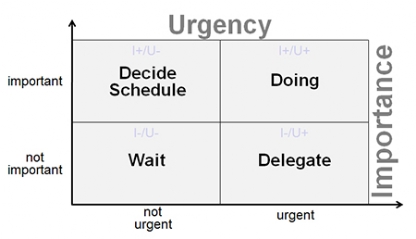Reaction matrix
Reaction matrix is a structure for the prioritization of tasks that was developed and used by Dwight D. Eisenhower. Sooner or later for everybody comes the time that the number of tasks, which can be done in the available time, cannot be fulfilled. Besides other selection mechanisms, like FIFO (First in – First out) or ABC analysis, the reaction matrix offers an approach that uses importance and urgency to create a classification of four options.
Therefore the following questions are answered for each task: Is the task important or not important?
A task becomes important through great significance for the client, strong influence on the entrepreneurial success or high value for oneself. Is the task urgent or not urgent?
The urgency results from deadline, completion duration or interdependences with other tasks that depend on the completion.
The result puts tasks in one of the four matrix areas: Doing, decide schedule, delegate and wait.

Doing
If the task is important and urgent, it should be started immediately and, if possible, be accomplished.
Decide schedule
If the task is important and not urgent, it should be scheduled. The schedule should be kept, in order to avoid any form of postponing.
Delegate
If the task is not important and urgent, somebody else should be found for completion and the task should be handed over.
Wait
If the task is not important and not urgent, nothing should be done. Everybody can decide to throw it away immediately or store these tasks on a pile and dispose them later.
